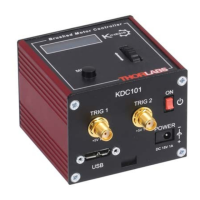59
K-Cube Brushed DC Servo Motor Driver
Output Trigger Modes
When the Trig 1 Mode and Trig 2 Mode parameters are configured as outputs, the
TRIG ports can be used as a general purpose digital output, or to indicate motion
status or to produce a trigger pulse at configurable positions as follows:
Digital Output - General purpose logic output (set using the LLSetGetDigOPs
method).
Trig Out In Motion - Trigger output active (level) when motor 'in motion'. The output
trigger goes high (5V) or low (0V) (as set in the Trig 1. Polarity and Trig. 2 Polarity
parameters) when the stage is in motion.
Trig Out Max Vel - Trigger output active (level) when motor at 'max velocity'.
Trig Out Pos. Steps Fwd - Trigger output active (pulsed) at pre-defined positions
moving forward. Only one Trigger port at a time can be set to this mode. See
Trigger Out Position Steps for further details.
Trig Out Pos. Steps Rev - Trigger output active (pulsed) at pre-defined positions
moving backwards. Only one Trigger port at a time can be set to this mode. See
Trigger Out Position Steps for further details.
Trig Out Pos. Steps Both - Trigger output active (pulsed) at pre-defined positions
moving forwards and backward. Only one Trigger port at a time can be set to this
mode. See Trigger Out Position Steps for further details.
Trigger Out Position Steps
In the last three modes described above, the controller outputs a configurable number
of pulses (set in the Num. Pulses Fwd and Num. Pulses Rev parameters), of
configurable width (Trig Pulse Width), when the actual position of the stage matches
the position values configured as the Start Position and Position Interval (Start Pos.
Fwd/Start Pos. Rev. and Pos Interval Fwd/Pos Interval Rev). These modes allow
external equipment to be triggered at exact position values.
The position pulses are generated by dedicated hardware, allowing a very low latency
of less than 1 usec. The low latency of this triggering mode provides a very precise
indication of a position match (assuming a stage velocity of 10 mm/sec, the less than
1 usec latency would in itself only result in a 10 nm position uncertainty, which is
normally well below the accuracy limitations of the mechanics.)
Using the last three modes above, position triggering can be configured to be
unidirectional (Trig Out Pos. Steps Fwd or Trig Out Pos. Steps Rev) or bidirectional
(Trig Out Pos. Steps Both). In bidirectional mode the forward and reverse pulse
sequences can be configured separately. A cycle count setting (Num. of Move
Note
If the trigger mode is not set to one of the three position modes described
previously, then the following parameters are not applicable and will be
greyed out.

